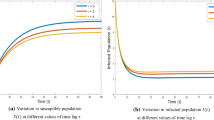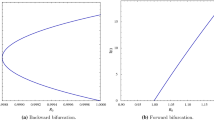Abstract
A novel nonlinear time-delayed susceptible–infected–recovered epidemic model with Beddington–DeAngelis-type incidence rate and saturated functional-type treatment rate is proposed and analyzed mathematically and numerically to control the spread of epidemic in the society. Analytical study of the model shows that it has two equilibrium points: disease-free equilibrium (DFE) and endemic equilibrium (EE). The stability of the model at DFE is discussed with the help of basic reproduction number, denoted by \({R_0}\), and it is shown that if the basic reproduction number \({R_0}\) is less than one, the DFE is locally asymptotically stable and unstable if \({R_0}\) is greater than one. The stability of the model at DFE for \({R_0}=1\) is analyzed using center manifold theory and Castillo-Chavez and Song theorem which reveals a forward bifurcation. We also derived the conditions for the stability and occurrence of Hopf bifurcation of the model at endemic equilibrium. Further, to illustrate the analytical results, the model is simulated numerically.








Similar content being viewed by others
References
Anderson RM, May RM (1978) Regulation and stability of host-parasite population. Interactions: I. Regulatory processes. J Anim Ecol 47:219–267
Anderson RM, May RM (1992) Infectious diseases of humans: dynamics and control. Oxford University Press, Oxford
Bailey NTJ (1975) The mathematical theory of infectious diseases and its applications. Griffin, London
Beddington JR (1975) Mutual interference between parasites or predators and its effect on searching efficiency. J Anim Ecol 44:331–340
Brauer F, Castillo-Chavez C (2001) Mathematical models in population biology and epidemiology. Springer, New York
Capasso V, Serio G (1978) A generalization of the Kermack–Mckendrick deterministic epidemic model. Math Biosci 42(1–2):43–61
Castillo-Chavez C, Song B (2004) Dynamical models of tuberculosis and their applications. Math Biosci Eng 1(2):361–404
DeAngelis DL, Goldstein RA, O’Neill RV (1975) A model for tropic interaction. Ecology 56:881–892
Dubey B, Patra A, Srivastava PK, Dubey US (2013) Modeling and analysis of an SEIR model with different types of nonlinear treatment rates. J Biol Syst 21(03):1350023
Dubey B, Dubey P, Dubey US (2015) Dynamics of an SIR model with nonlinear incidence and treatment rate. Appl Appl Math 10(2):718–737
Dubey P, Dubey B, Dubey US (2016) An SIR model with nonlinear incidence rate and Holling type III treatment rate. In: Cushing J, Saleem M, Srivastava H, Khan M, Merajuddin M (eds) Applied analysis in biological and physical sciences. Springer proceedings in mathematics and statistics, vol 186. Springer, New Delhi, pp 63–81
Elaiw AM, Azoz SA (2013) Global properties of a class of HIV infection models with Beddington–DeAngelis functional response. Math Methods Appl Sci 36:383–394
Gumel AB, McCluskey CC, Watmough J (2007) An SVEIR model for assessing potential impact of an imperfect anti-SARS vaccine. Math Biosci Eng 3(3):485–512
Hattaf K, Lashari AA, Louartassi Y, Yousfi N (2013) A delayed SIR epidemic model with general incidence rate. Electron J Qual Theory Differ Equ 3:1–9
Hethcote HW, van den Driessche P (1995) An SIS epidemic model with variable population size and a delay. J Math Biol 34(2):177–194
Kaddar A (2010) Stability analysis in a delayed SIR epidemic model with a saturated incidence rate. Nonlinear Anal Model Control 15:299–306
Kermack WO, McKendrick AG (1927) A contribution to the mathematical theory of epidemics. Proc R Soc Lond A 115:700–721
Korobeinikov A (2007) Global properties of infectious disease models with nonlinear incidence. Bull Math Biol 69(6):1871–1886
Korobeinikov A, Maini PK (2005) Nonlinear incidence and stability of infectious disease models. Math Med Biol 22:113–128
Kuang Y (1993) Delay differential equations with applications in population dynamics. Academic Press, Boston
Kumar A, Nilam (2018a) Stability of a time delayed SIR epidemic model along with nonlinear incidence rate and Holling type-II treatment rate. Int J Comput Methods 15(6):1850055
Kumar A, Nilam (2018b) Dynamical model of epidemic along with time delay: Holling type II incidence rate and Monod–Haldane type treatment rate. Differ Equ Dyn Syst. https://doi.org/10.1007/s12591-018-0424-8
Li MY, Muldowney JS (1995) Global stability for the SEIR model in epidemiology. Math Biosci 125:155–164
Li X, Li W, Ghosh M (2009) Stability and bifurcation of an SIR epidemic model with nonlinear incidence and treatment. Appl Math Comput 210:141–150
McCluskey CC (2010) Global stability for an SIR epidemic model with delay and nonlinear incidence. Nonlinear Anal RWA 11(4):3106–3109
Mena-Lorca J, Hethcote HW (1992) Dynamic models of infectious disease as regulators of population size. J Math Biol 30(7):693–716
Mukherjee D (1996) Stability analysis of an S-I epidemic model with time delay. Math Comput Model 24(9):63–68
Ruan S, Wei J (2003) On the zeros of transcendental functions with applications to stability of delay differential equations with two delays. Dyn Contin Discrete Impuls Syst Ser A 10:863–874
Sastry S (1999) Analysis, stability and control. Springer, New York
Song X, Cheng S (2005) A delay-differential equation model of HIV infection of CD4+ T-cells. J Korean Math Soc 42(5):1071–1086
Tipsri S, Chinviriyasit W (2014) Stability analysis of SEIR model with saturated incidence and time delay. Int J Appl Phys Math 4(1):42–45
Van den Driessche P, Watmough J (2002) Reproduction numbers and sub-threshold endemic equilibria for compartmental models of disease transmission. Math Biosci 180:29–48
Wang X (2004) A simple proof of Descartes’s rule of signs. Am Math Mon. https://doi.org/10.2307/4145072
Wang W (2006) Backward bifurcation of an epidemic model with treatment. Math Biosci 201(1):58–71 pmid:16466756
Wang W, Ruan S (2004) Bifurcations in an epidemic model with constant removal rate of the infectives. J Math Anal Appl 291(2):775–793
Wei C, Chen L (2008) A delayed epidemic model with pulse vaccination. Discrete Dyn Nat Soc. https://doi.org/10.1155/2008/746951
Xu R, Ma Z (2009a) Global stability of a SIR epidemic model with nonlinear incidence rate and time delay. Nonlinear Anal RWA 10(5):3175–3189
Xu R, Ma Z (2009b) Stability of a delayed SIRS epidemic model with a nonlinear incidence rate. Chaos Solitons Fractals 41(5):2319–2325
Yang M, Sun F (2015) Global stability of SIR models with nonlinear Incidence and discontinuous treatment. Electron J Differ Equ 2015(304):1–8
Zhang JZ, Jin Z, Liu QX, Zhang ZY (2008) Analysis of a delayed SIR model with nonlinear incidence rate. Discrete Dyn Nat Soc. https://doi.org/10.1155/2008/636153
Zhang Z, Suo S (2010) Qualitative analysis of an SIR epidemic model with saturated treatment rate. J Appl Math Comput 34:177–194
Acknowledgements
The authors acknowledged the support of Delhi Technological University, Delhi, India, for giving monetary help to complete this research work. They are also indebted to the anonymous reviewers and the handling editor for their constructive comments and suggestions which have enhanced the paper.
Author information
Authors and Affiliations
Corresponding author
Additional information
Publisher’s Note
Springer Nature remains neutral with regard to jurisdictional claims in published maps and institutional affiliations.
Rights and permissions
About this article
Cite this article
Goel, K., Nilam A mathematical and numerical study of a SIR epidemic model with time delay, nonlinear incidence and treatment rates. Theory Biosci. 138, 203–213 (2019). https://doi.org/10.1007/s12064-019-00275-5
Received:
Accepted:
Published:
Issue Date:
DOI: https://doi.org/10.1007/s12064-019-00275-5
Keywords
- Epidemic model
- Beddington–DeAngelis-type incidence rate
- Saturated treatment rate
- Stability
- Bifurcation
- Center manifold theory




